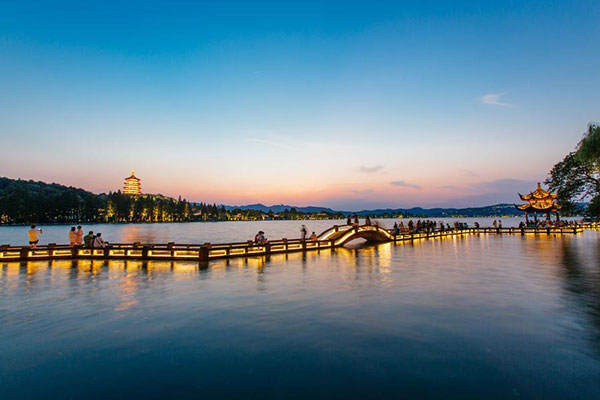
(Photo/Xinhua)
Hangzhou is now in the spotlight as the host of this year's G20 summit, from September 4-5.[Special Coverage]
Hangzhou, the capital city of East China's Zheijiang province, is one of the seven ancient capitals of China, having served as the capital of the Wuyue Kingdom during the Five Dynasties (AD 907-960) and the Southern Song Dynasty (1127-1279). As a core city of the Yangtze River Delta, Hangzhou has been one of the most prosperous cities in China for more than 1,000 years, and is home to a myriad of natural attractions and historical legacies.
Marco Polo, the famous 13th century Italian traveler and merchant, described Hangzhou as "beyond dispute, the finest and the noblest in the world".
Now as Hangzhou has grabbed the world's attention, tourists from various places have gathered to this heavenly city to enjoy its slow life tempo and beautiful natural surroundings. Here are some highlights of the city you can't miss.
1 West Lake
The West Lake is definitely a place people can never miss when visiting Hangzhou. The lake itself covers 6 sq km, and includes some of Hangzhou's most famous scenic places.
There are "10 scenes of West Lake" and "10 new scenes", but it is not necessary to make a checklist and walk back and forth to look for these scenic spots.
Just walk casually along the Nanshan and Beishan roads and the causeways, take a ferry on the boat to the islands on the lake, or simply sit in a lakeside teahouse and enjoy the picturesque views and the longjing (dragon well) tea.
The lake is situated in the center of the city, with convenient public transport access. The Hangzhou government also offers free public bikes for tourists to travel around the lake. The parks around the lake are all free to visit.
2 Lingyin Temple
Lingyin, or the Temple of the Soul's Retreat, has historically been the most renowned destination for Buddhist pilgrims in the Yangtze River Delta.
The monastery was founded in 326 during the Eastern Jin Dynasty (317-420), purportedly by the Indian monk Hui Li. In the 10th century, when Hangzhou was the capital city of the Buddhist Wuyue Kingdom, the temple for the first time gained its unprecedented importance.
The temple has undergone several restorations, the latest of which was in the 1970s at the urging of Premier Zhou Enlai. Lingyin Temple is now considered one of the largest Buddhist complexes in the country.
Upon entering the Great Hall of the monastery, visitors will see a 200-year-old statue of Maitreya, also known as the Laughing Buddha, which has a huge belly. The Four Heavenly Kings, or Buddhist guardians, stand on either side of Maitreya.
Visitors then enter the main hall of the temple complex, the Jeweled Hall of the Great Heroes, or Da Xiong Bao Dian in Chinese. It houses a 64-foot-high statue of Sakyamuni, a representation of the Buddha himself, Siddhartha Gautama. Covered with gold leaf, Sakyamuni is thought to be the largest sitting Buddha statue in China.
The temple grounds also hold a household and mystical hill called the Peak Flying from Afar, a limestone pinnacle over 209 m high.


















































